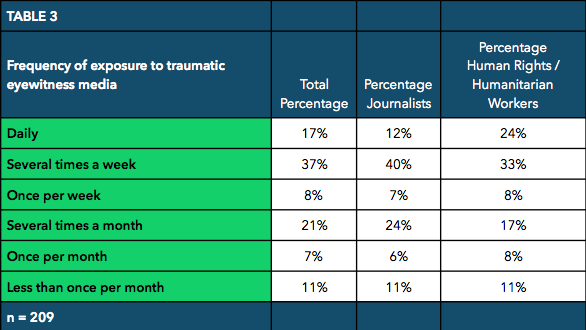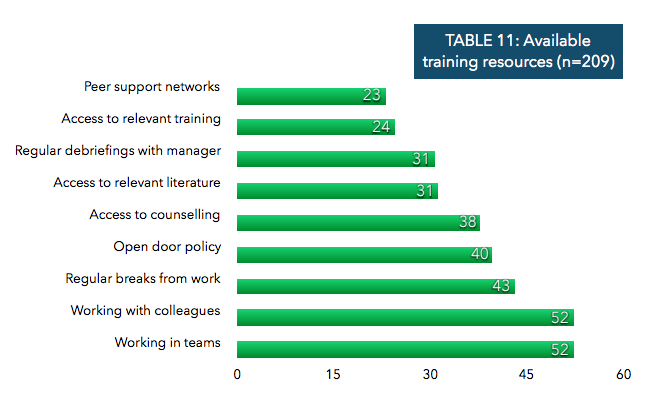
By Alastair Reid
The growing number of smartphones and social media accounts means eyewitnesses to a news event can share images with the world in an instant, images that too often show the grisly side of current events.
New research published yesterday by Eyewitness Media Hub (EMHub) lends some scientific weight to the anecdotal evidence shared in many newsrooms around the world: the amount of graphic images seen in newsrooms is rising and with it the issue of vicarious trauma among journalists.
“In the past, a professional cameraperson would get to the scene maybe ten minutes after the incident,” said EMHub co-founder Sam Dubberley, revealing the report yesterday at the BBC’s London offices, “but now we’re seeing ten different angles exactly as it happens.”
This flood of graphic imagery is also now stored by news organisations in a different way, so “anyone, anywhere can see anything that’s on the video server”, he said, and “these different workflow changes have had a massive impact on the amount and ways people see traumatic content”.
The research report, “Making Secondary Trauma a Primary Issue: A Study of Eyewitness Media and Vicarious Trauma on the Digital Frontline”, details the prevalence of graphic imagery in newsrooms and the impact on journalists and human rights workers.
More than 50 per cent of journalists who took part in the survey reported viewing traumatic eyewitness media several times a week, and nearly 40 per cent said it had high or very high adverse effects on their personal life. Sixteen percent said it affected their professional life.

More than half of journalists in the survey reported seeing traumatic images several times a week or more. Screenshot from Making Secondary Trauma a Primary Issue: A Study of Eyewitness Media and Vicarious Trauma on the Digital Frontline
“I have never seen the volume and level of violence, day in day out, in six years of working in warzones as some young journalists do every day in large newsrooms on social media,” said Professor Liz Griffin, an expert in human rights and co-author of the report.
As a result, the frontline of covering conflict and human rights abuses has moved into the newsroom, said Dubberley, and journalists who work in the field and on the “digital frontline” should be treated in the same way, with similar training to reflect and cater for the hazards of the job.
A major contributing factor to the impact of graphic images on journalists is the element of surprise, said Dubberley, with more than three quarters of interviewees more affected by graphic images if they had not had time to prepare themselves.
News organisations do provide support for their staff, respondents said, but too often the most effective kinds of support is in the shortest supply.
Three of the four methods deemed most effective in helping respondents cope with trauma – peer support networks, regular debriefings with editors or managers and access to relevant training – were ranked the lowest in terms of their availability to staff.

How useful certain resources are to coping with traumatic eyewitness media. Screenshot from Making Secondary Trauma a Primary Issue: A Study of Eyewitness Media and Vicarious Trauma on the Digital Frontline

The availability of resources to help staff cope with viewing traumatic eyewitness media. Screenshot from Making Secondary Trauma a Primary Issue: A Study of Eyewitness Media and Vicarious Trauma on the Digital Frontline
The full report is well worth reading for a fuller understanding of how graphic or traumatic images are affecting newsrooms and, more importantly, what factors can limit or predict the impact of traumatic imagery on those who have to view it for work.
The authors compiled a list of tips and advice for anyone working in the field:
• Be aware that you and your colleagues are at risk of vicarious trauma as a result of working with distressing eyewitness media content.
• Educate yourself about vicarious trauma and PTSD and learn how to recognise symptoms, starting with the Dart Center’s tips for working with traumatic imagery.
• Recognise that it is an entirely normal human reaction to experience negative emotions as a direct consequence of viewing traumatic eyewitness media, in particular when one views such images on a regular basis and for prolonged durations.
• If you are experiencing negative emotions or feel that your are displaying symptoms of vicarious trauma do not feel guilty and/or ashamed. Understand that you are only human. You are not alone in experiencing such feelings.
• Be aware that working with distressing eyewitness media in an office has the potential to be as traumatic as working in the field because you are likely to be viewing far more graphic and disturbing acts on a more frequent basis.
• If you believe that you are experiencing symptoms of vicarious trauma or any other mental health condition, talk to someone whom you trust about how you feel – a family member, friend, colleague, manager or mental health professional. Never isolate yourself or feel ashamed of expressing how you feel. Do not feel ashamed or guilty about seeking professional counselling.
• Develop healthy coping mechanisms in the office. These can include (but are not limited to) regular breaks; getting out of the office periodically; taking time out to view positive images or reading light or inspirational literature. Where possible limit your exposure to traumatic eyewitness media – ask yourself and your colleagues and managers (where you feel comfortable to do so) if you really need to view a particular image that you might find distressing.
• When viewing traumatic eyewitness media, minimise the sound, pause the video periodically and move away from your desk before completing the viewing. If you know that the video ends with an execution or an extreme act of violence, ask yourself whether you really need to watch the whole video to gain the information that you need to do your job.
• Ensure that you do not share distressing content with colleagues without warning them what they are about to be exposed to. Unexpectedly viewing eyewitness media that is disturbing can cause additional distress and trauma.
• Try to identify the specific types of traumatic eyewitness media that have a more disturbing impact upon you. Where possible, let your colleagues and managers know that you find particular types of content (content featuring children, for instance) more traumatic.
• Develop a personal care plan and incorporate healthy coping mechanisms into your daily life. Request that your organisation engages professional mental health experts to provide training and support on vicarious trauma.
• Where possible ask managers and human resources personnel to disseminate information about the resources that are available and the policies within your organisation to support staff working with traumatic eyewitness media.
• If you feel that your organisation is failing in its duty of care to prevent, mitigate or assist staff from vicarious trauma, seek independent professional advice from your union or a lawyer and document your experience.
• Understand that vicarious trauma and PTSD can be caused by exposure to traumatic eyewitness media in headquarters. PTSD is not only caused by exposure to distressing acts witnessed by staff deployed in the field. Managers need to ensure appropriate care is provided for staff working in both environments.
• Recognise that it is an entirely normal human reaction to experience negative emotions as a direct consequence of viewing traumatic eyewitness media. In particular, when your staff view such images on a regular basis and for prolonged durations.
• Be aware that your staff who work in the office with distressing eyewitness media may be more vulnerable to vicarious trauma than employees working in the field because they are likely to be viewing far more graphic and disturbing acts on a more frequent basis than staff in the field.
• Educate yourself about the content, frequency and duration of the disturbing eyewitness media your staff view if you do not already know.
• Pay particular attention to staff who may be more exposed to traumatic eyewitness media due to specific skill sets (Arabic language skills, or digital skills, for instance). Ensure they receive particular attention to mitigate vicarious trauma.
• Educate yourself about vicarious trauma and PTSD and learn how to recognise symptoms that may manifest themselves in your staff, starting with the Dart Center’s tips for working with traumatic imagery. If you believe that a staff member is displaying symptoms of vicarious trauma rotate that staff member off hard news and provide them with support (e.g. talk to them, offer them free counselling or offer them paid leave).
• Include in job descriptions, adverts and/or terms of reference a clear indication of the fact that a job can entail viewing traumatic eyewitness media and indicate the frequency with which they will be expected to view such content.
• When interviewing and hiring new staff members ensure they are briefed and aware that they could potentially see traumatic eyewitness media in the role. Where possible verbally inform people at the interview stage of the specific types of content (talk them through real examples) that they are likely to be viewing and ask them if they feel able to view such content on a daily basis.
• Develop technical workflows and recommendations to ensure staff do not share distressing content with colleagues without a warning. Unexpectedly viewing eyewitness media that is disturbing can cause additional distress and trauma.
• Include training on viewing traumatic imagery in induction sessions for all new staff, including how to identify and deal with the symptoms of vicarious trauma and PTSD.
• Hold regular team debriefings for staff working with traumatic eyewitness media.
• Review organisational policies, including any health insurance plans offered to staff, to ensure they pay attention to staff members who experience vicarious trauma as a result of viewing eyewitness media.
• Ensure that your organisation provides free counselling for unlimited periods to all staff that request it. Never make a staff member feel that they are weak or not up to the job if they approach you to discuss vicarious trauma.
• Ensure that your organisation disseminates information about vicarious trauma and PTSD to all staff and that helpline numbers and other resources are available and clearly visible on computers and in staff rest areas.
• Make your office environment as comfortable as possible. For example: ensure staff have access to natural light and that staff feel comfortable taking breaks when they feel it is necessary.
• Recognise that taking steps to prevent, mitigate and support staff suffering from secondary trauma is an investment in your organisation as it will prevent high turnovers of staff and make your staff more productive.
• Ensure that, before introducing new social media newsgathering techniques into the newsrooms, the potential for viewing more distressing or traumatic content is taken into account.
• Ensure workflows for introducing video on to general servers includes warnings of traumatic content.
• Ensure staff rotation policies are in place to ensure staff are given breaks from viewing distressing or traumatic content during shifts. Also ensure that viewing social media is not left to one staff member during any given shift.